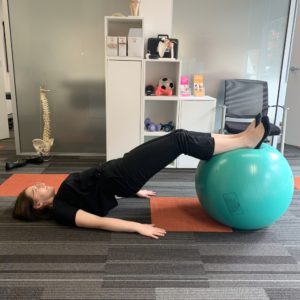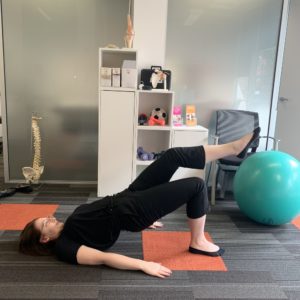A commonly prescribed exercise which is used in the early stages of rehabilitation is bridging. Bridging is a functional exercise which is used to strengthen the gluteals, hamstrings and lower limb and can be easily incorporated into daily activity.
There are many different types of bridges that can be prescribed depending on your area of pain or overall problem. Sometimes it can be difficult to know where you are supposed to feel the exercise working and whether you are doing it correctly.
Here are a few of my favorite bridging variations and tips, not all of these are suitable for everyone so please ask your physiotherapist before starting different bridging exercises.
- Gluteal bridges
This is the most commonly prescribed bridging exercise that we see. This exercise is great to help promote gluteal strength and can also be used, when taught right, for segmental mobility through the lower back.
To ensure that this exercise is completed properly it is important that your hips are above the level of the ribs, knees at least to 90 degrees and you should feel it working in the bottom muscles, rather than the legs or lower back.
In the picture I have my toes off the floor and you can add this in to increase the amount of gluteal activation, similarly you can come up onto your toes to increase the amount of work in your calves, it will also challenge your balance!
- Hamstring bridges
Hamstring bridges are another commonly prescribed exercise that is great at increasing hamstring strength and control.
Similar to the gluteal bridge it is important to ensure that the hips and pelvis stay above the ribs. Your knees need to be a little further away from the body for this exercise and the lower legs need to be supported by a box or ball. To ensure that it is being performed correctly you should feel it working through the back of the legs, rather than the lower back or bottom.
In this picture I have my feet supported by a ball, to start off it is better to start with a more stable surface such as a bench or a box. This exercise can be made more challenging by having the legs straighter as it increases the amount of hamstring work or having your feet on a ball and drawing it inwards towards the body then outwards.
- Single leg bridges
If your hamstring or gluteal bridges are getting too easy it may be time to progress them! Single leg bridges are a great way of increasing the difficulty of the exercise. You are putting all your weight through one side with this exercise so it puts extra load through the hamstring, lower limb and gluteals. Single leg bridges also require much more control and stability through the lower back, pelvis and abdominals, making it a great stability exercise!
The other benefits of completing a single leg bridge it that you get some lower abdominal activation to maintain the leg that is up in the air in the table top position.
It is important when completing this exercise that that the ribs stay below the hips but it is also important to ensure that the hips remain level and don’t drop or rotate during the exercise. Depending on how you are completing the exercise, you will feel it working in your bottom muscles and in the back of the legs
If you are looking to change your exercise routine or need an exercise program to get you started for 2020, book in and see one of our Bend + Mend Physios in Sydney CBD.








